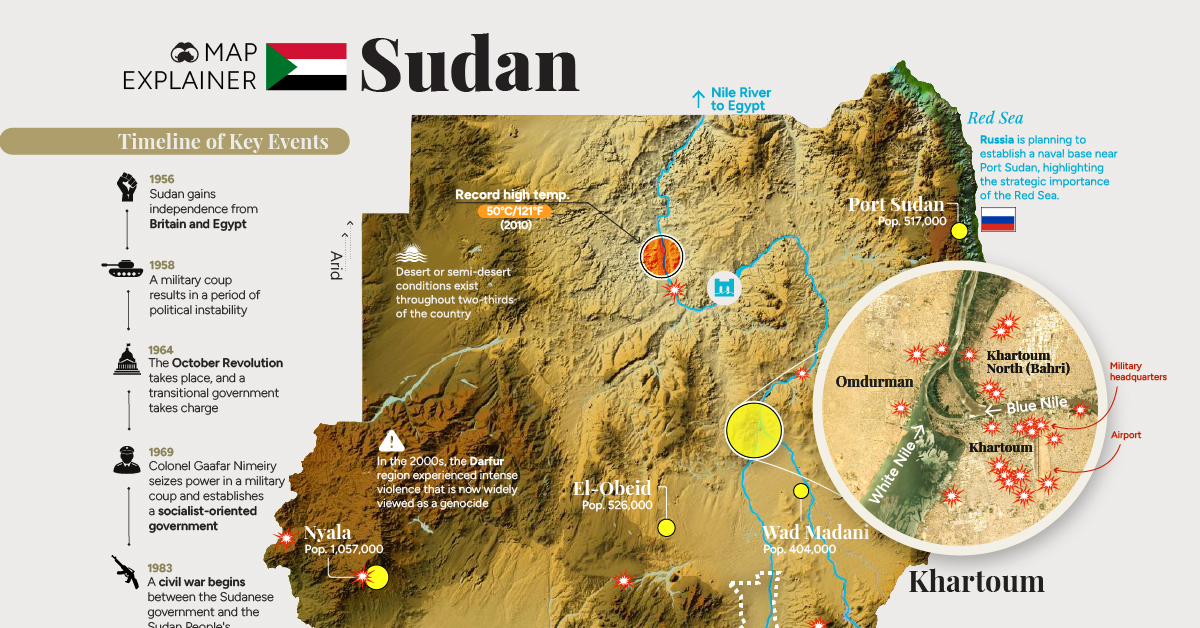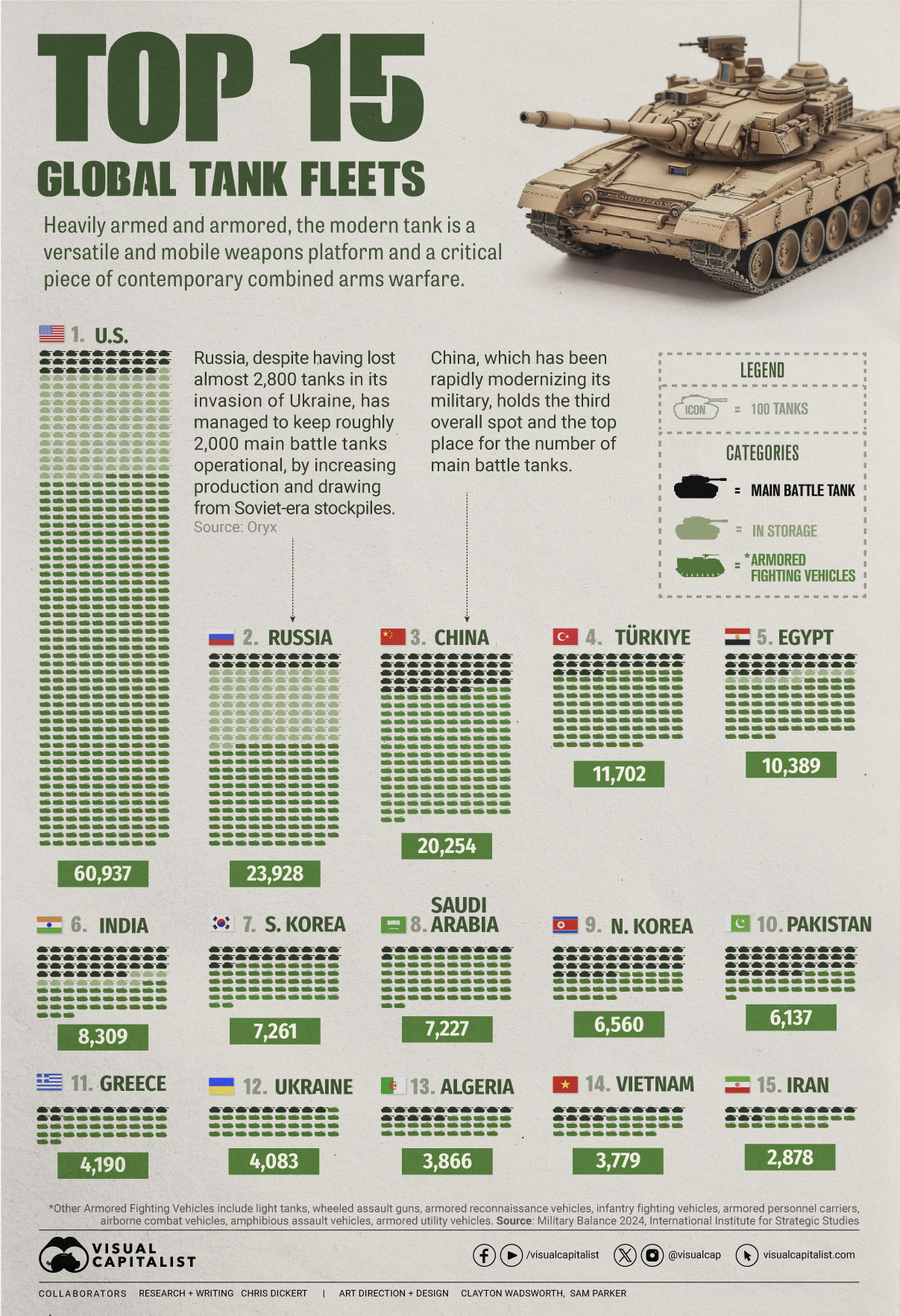War
Map Explainer: Sudan
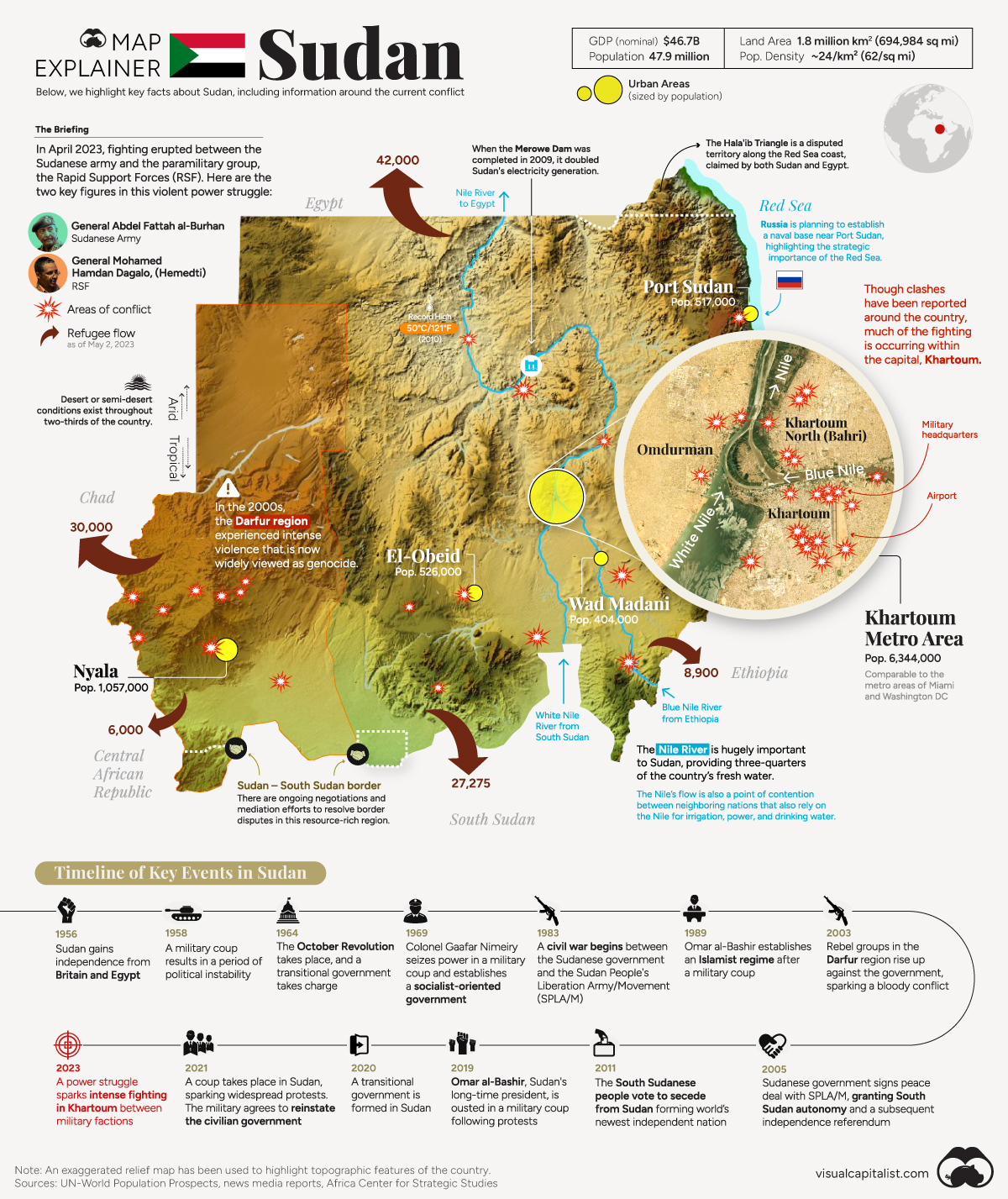
Map Explainer: Sudan
The African nation of Sudan has been in the headlines, as intense fighting has rocked the country. As this bloody power struggle plays out, the map infographic above aims to provides key information on the conflict, as well as general facts and context about the country.
To begin, what exactly is happening in Sudan?
The 2023 Conflict in Sudan: A Primer
As explosions echo throughout Khartoum—Africa’s sixth largest urban area—many around the world are left wondering how the conflict escalated to this point. Here are five things to know:
- Two generals have been sharing power since a coup in 2021. The first is General Abdel Fattah al-Burhan, who leads the Sudanese Army. The second is General Mohamed Hamdan Dagalo (aka Hemedti), who leads the Rapid Support Forces (RSF) paramilitary group. This power-sharing arrangement was meant to be temporary, with an eventual transition to a civilian-led democracy. Instead, the situation devolved into conflict.
- Fighting broke out around the country in mid-April, with Khartoum becoming a major flash point. Flames billowed over the Khartoum airport, and the city’s military headquarters was reduced to a burned-out husk.
- As violence began to grip Sudan’s largest city, there was an exodus of foreign officials and citizens. In one particularly dramatic scene at the U.S. Embassy, nearly 100 people were escorted onto an aircraft by Navy SEALs and flown to nearby Djibouti.
- There have been a number of ceasefire agreements so far, but they’ve done little to stem the intense fighting.
- The stream of refugees fleeing the violence continues to grow. There is growing concern that this conflict will cause further instability in the region, as most of Sudan’s neighbors have their own histories with recent conflict, and many areas are facing food insecurity.
Unfortunately, Sudan is no stranger to conflict, having been ruled by the military for much of its existence. As of the writing of this article, there is technically a ceasefire in place, but fighting rages on. It remains to be seen how far these warring generals are willing to push the situation to assert their power.
Fast Facts About the Country of Sudan
Beyond headlines of conflict, Sudan is not a well-known country to many in the West. In the map above, we’ve also included more general information about geography, climate, population centers, and more.
Geography and Climate
Sudan is the third largest nation in Africa (16th globally), so there is a lot of climate and geographic variance within the country’s borders.
The country is located in Northeast Africa, directly below Egypt. Roughly speaking, its climate changes along a north–south axis, moving from arid to tropical. About two-thirds of the nation is arid and semi-arid, which is typical of countries with territory that includes the Sahara Desert.
The further south one goes in Sudan, the greener the surroundings get. The map below (which also includes the relatively new country of South Sudan) shows the extreme difference in vegetation from the north to south in the region.
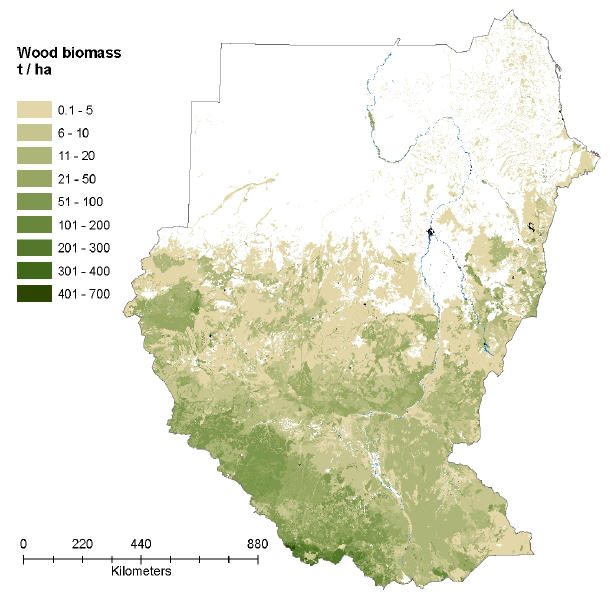
The Nile River is a prominent feature running across this arid region, providing two-thirds of the country’s fresh water. In the south, the Blue and White portions of the Nile enter the country from South Sudan and Ethiopia, respectively. The rivers meet midway through the country and the Nile River flows northward, eventually reaching Egypt.
This flow of water from country-to-country can sometimes be a point of contention between Sudan, South Sudan, Ethiopia, and Egypt, who all rely on the river for power, fresh water, and irrigation.
Population Centers
Over 43 million people live in Sudan, which ranks it ninth in terms of population in Africa. Below, we can see that much of the Sudanese population is clustered in a couple of key areas, while much of the country remains sparsely populated.
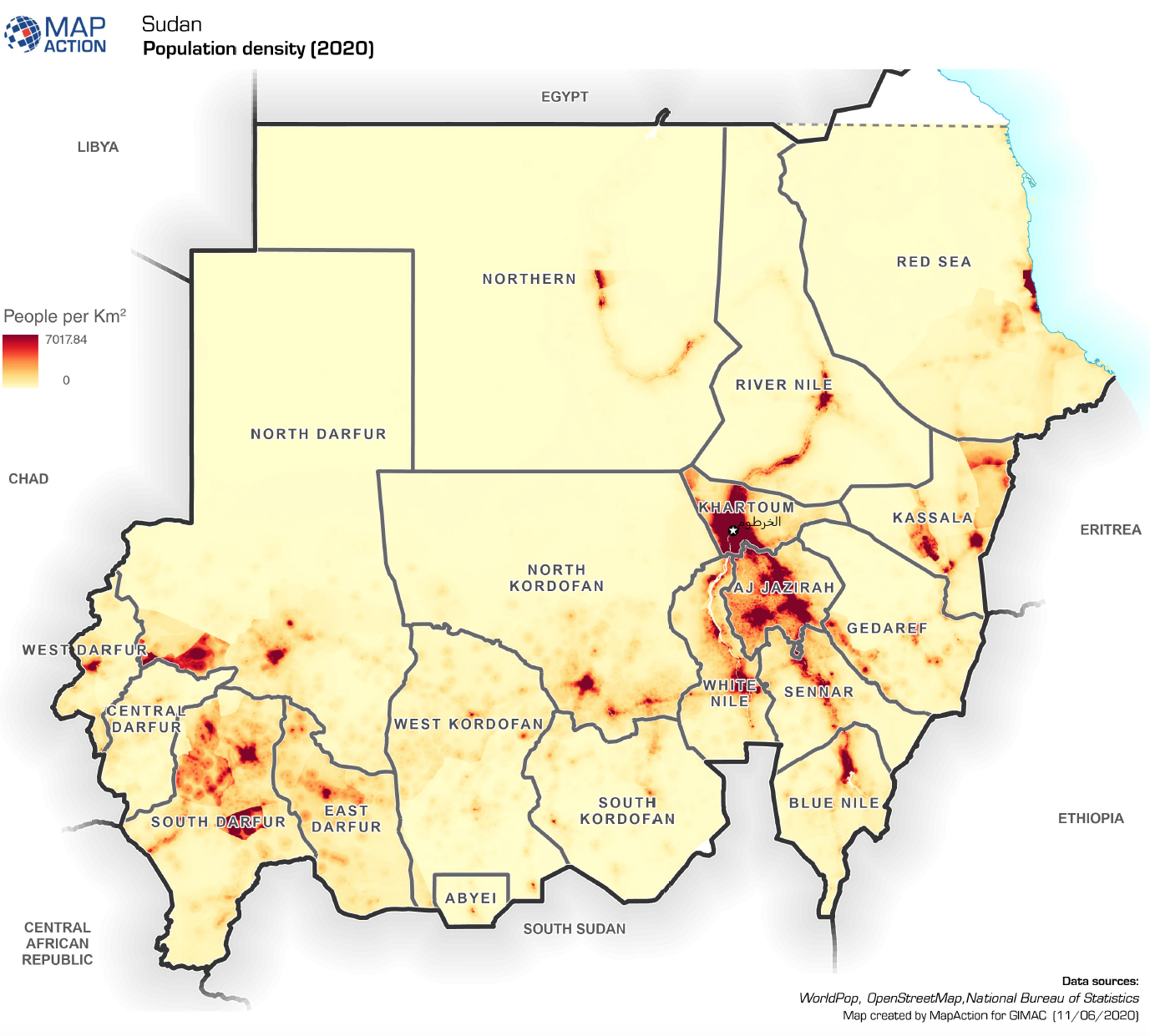
Khartoum, the capital and largest city, is located in the interior of the country at the strategic point where the Blue and White Niles converge. This fast-growing city is shaped by the three sections surrounding the river junction—with Khartoum, North Khartoum, and Omdurman making up a metro area of 6.3 million people.
Sudan is divided into 18 states, five of which form the Darfur region in the west. If the name Darfur is familiar, it’s for good reason. In the 2000s, the region experienced a conflict marked by widespread violence, human rights abuses, and displacement, resulting in a humanitarian crisis. One of the generals involved in the current crisis, Hemedti, previously commanded the Janjaweed militias, which carried out some of the most egregious atrocities of the Darfur conflict.
In the northwest, Sudan borders the strategic Red Sea route. Port Sudan serves as the main entry point for imports and the primary export outlet for Sudanese commodities, including agricultural products (such as cotton, gum arabic, and sesame), minerals (such as gold), and livestock. The city has also been tapped to host a Russian naval base in the near future, though the recent power struggle in Sudan has potentially complicated negotiations.
As violence continues to rage in residential areas and people flee for safer areas, it remains to be seen how this conflict will influence population patterns within the country. How many people will be displaced? And once the smoke clears, will they return?
War
Visualized: Top 15 Global Tank Fleets
Heavily armed and armored, the modern tank is a versatile and mobile weapons platform, and a critical piece of contemporary warfare.
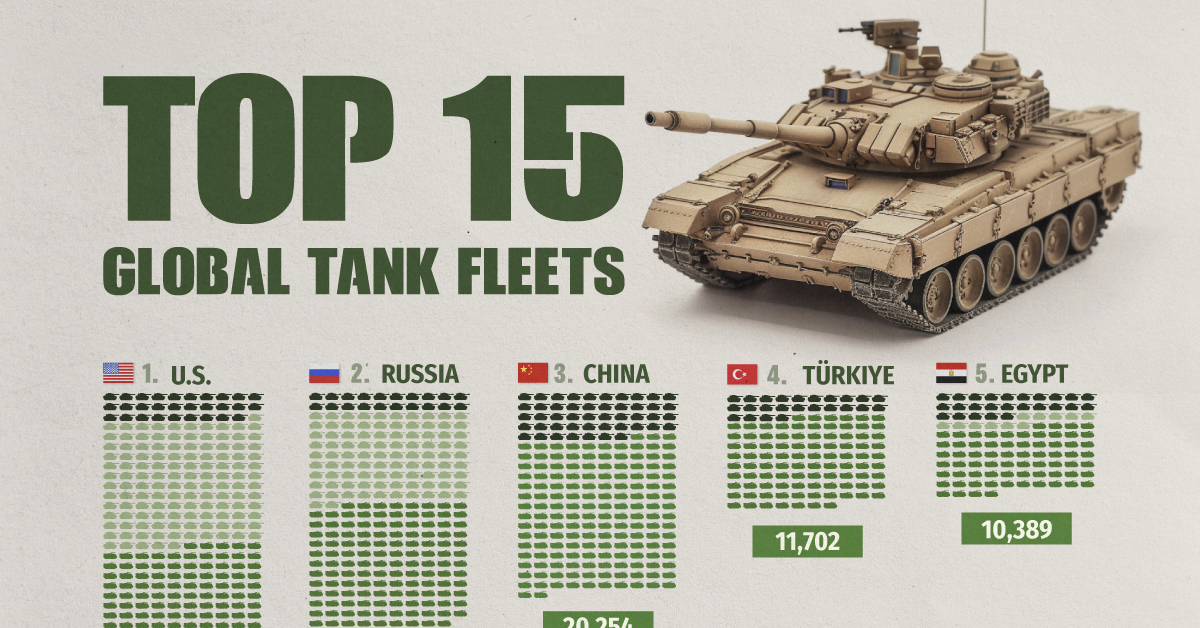
The Top 15 Global Tank Fleets
This was originally posted on our Voronoi app. Download the app for free on iOS or Android and discover incredible data-driven charts from a variety of trusted sources.
Heavily armed and armored, the modern tank is a versatile and mobile weapons platform, and a critical piece of contemporary warfare.
This visualization shows the top 15 global tank fleets, using data from the 2024 Military Balance report from the International Institute for Strategic Studies (IISS).
Let’s take an in-depth look at the top three fleets:
1. United States
As the world’s pre-eminent military power, it’s perhaps no surprise that the United States also has the largest tank fleet, by a wide margin.
In total, they have just over 45,000 armored fighting vehicles in operation, along with 2,640 main battle tanks (MBTs), and 12,800 vehicles in storage, of which 2,000 are main battle tanks.
| Category | Vehicles | Global rank |
|---|---|---|
| Main battle tanks | 2,640 | 4 |
| Armored reconnaissance | 1,745 | 1 |
| Infantry fighting vehicles | 3,262 | 3 |
| Armored personnel carriers | 10,644 | 1 |
| Amphibious assault vehicles | 1,401 | 1 |
| Armored utility vehicles | 28,445 | 1 |
| Storage | 12,800 | 1 |
| Total | 60,937 | 1 |
The U.S. is internalizing the lessons from the ongoing invasion of Ukraine, where Western-supplied anti-tank weapons and massed Ukrainian artillery have been cutting Russian tanks to pieces. As a result, the U.S. recently canceled an upgrade of the M1 Abrams in favor of a more ambitious upgrade.
Meanwhile, the U.S. is nervously eyeing a more confident China and a potential clash over Taiwan, where air and naval forces will be critical. However, a recent war game showed that Taiwanese mechanized ground forces, kitted out with American-made tanks and armored fighting vehicles, were critical in keeping the island autonomous.
2. Russia
According to Oryx, a Dutch open-source intelligence defense website, at time of writing, Russia has lost almost 2,800 main battle tanks since invading Ukraine. Considering that in the 2022 edition of the Military Balance, Russia was estimated to have 2,927 MBTs in operation, those are some hefty losses.
Russia has been able to maintain about 2,000 MBTs in the field, in part, by increasing domestic production. Many defense plants have been taken over by state-owned Rostec and now operate around the clock. Russia is also now spending a full third of their budget on defense, equivalent to about 7.5% of GDP.
At the same time, they’ve also been drawing down their Soviet-era stockpiles, which are modernized before being sent to the front. Just how long they can keep this up is an open question; their stockpiles are large, but not limitless. Here is what their storage levels look like:
| Category | 2023 | 2024 | YOY change |
|---|---|---|---|
| Main battle tanks | 5,000 | 4,000 | -20.0% |
| Armored reconnaissance | 1,000 | 100 | -90.0% |
| Infantry fighting vehicles | 4,000 | 2,800 | -30.0% |
| Armored personnel carriers | 6,000 | 2,300 | -61.7% |
| Total | 16,000 | 9,200 | -42.5% |
3. China
China holds the third overall spot and top place globally for the number of main battle tanks in operation. Untypically, the People’s Liberation Army has no armored vehicles in storage, which perhaps isn’t surprising when you consider that China has been rapidly modernizing its military and that stockpiles usually contain older models.
China also has one of the world’s largest fleets of armored fighting vehicles, second only to the United States. Breaking down that headline number, we can also see that they have the largest number of light tanks, wheeled guns, and infantry fighting vehicles.
| Category | Vehicles | Global rank |
|---|---|---|
| Main battle tanks | 4,700 | 1 |
| Light tanks | 1,330 | 1 |
| Wheeled guns | 1,250 | 1 |
| Infantry fighting vehicles | 8,200 | 1 |
| Armored personnel carriers | 3,604 | 5 |
| Airborne combat vehicles | 180 | 2 |
| Amphibious assault vehicles | 990 | 2 |
| Total | 20,254 | 3 |
This is equipment that would be integral if China were to make an attempt to reunify Taiwan with the mainland by force, where lightly armored mechanized units need to move with speed to occupy the island before Western allies can enter the fray. It’s worth noting that China also has one of the world’s largest fleets of amphibious assault vehicles.
End of the Tank?
Many commentators at the outset of Russia’s invasion of Ukraine, were quick to predict the end of the tank, however, to paraphrase Mark Twain, reports of the tank’s demise are greatly exaggerated.
With the U.S. and China both developing remote and autonomous armored vehicles, tanks could be quite different in the future, but there is nothing else that matches them for firepower, mobility, and survivability on the modern battlefield today.
-

 Science1 week ago
Science1 week agoVisualizing the Average Lifespans of Mammals
-

 Markets2 weeks ago
Markets2 weeks agoThe Top 10 States by Real GDP Growth in 2023
-

 Demographics2 weeks ago
Demographics2 weeks agoThe Smallest Gender Wage Gaps in OECD Countries
-

 United States2 weeks ago
United States2 weeks agoWhere U.S. Inflation Hit the Hardest in March 2024
-

 Green2 weeks ago
Green2 weeks agoTop Countries By Forest Growth Since 2001
-

 United States2 weeks ago
United States2 weeks agoRanked: The Largest U.S. Corporations by Number of Employees
-

 Maps2 weeks ago
Maps2 weeks agoThe Largest Earthquakes in the New York Area (1970-2024)
-

 Green2 weeks ago
Green2 weeks agoRanked: The Countries With the Most Air Pollution in 2023




